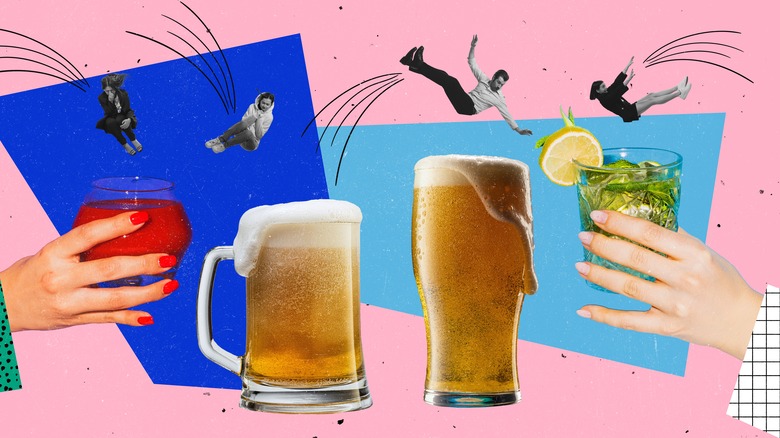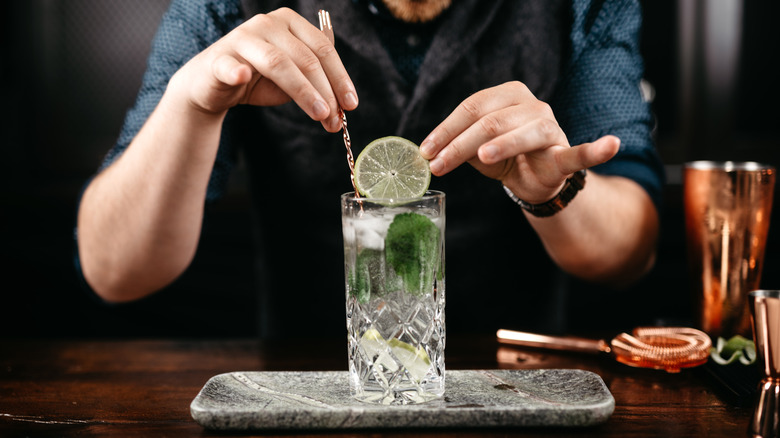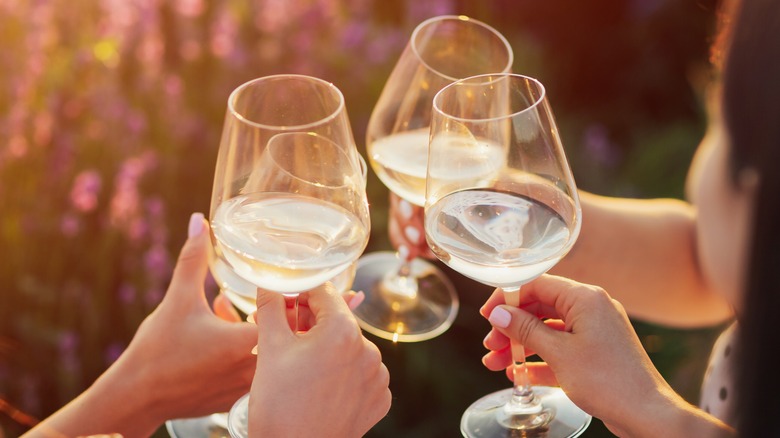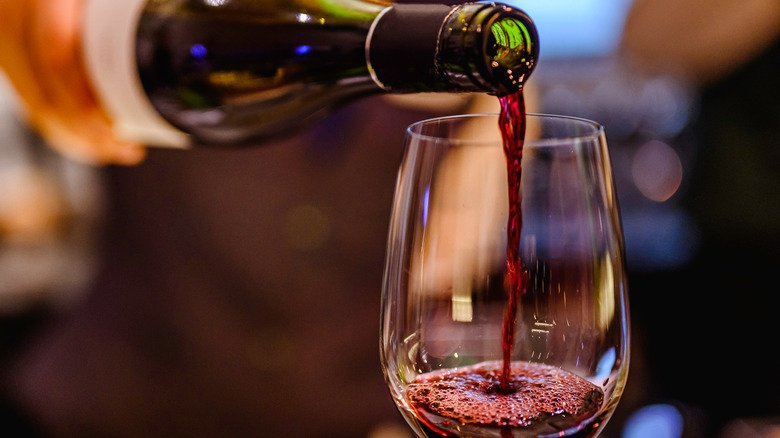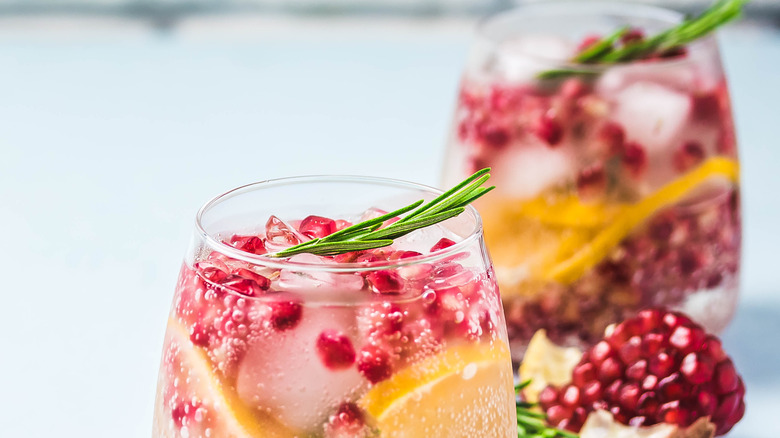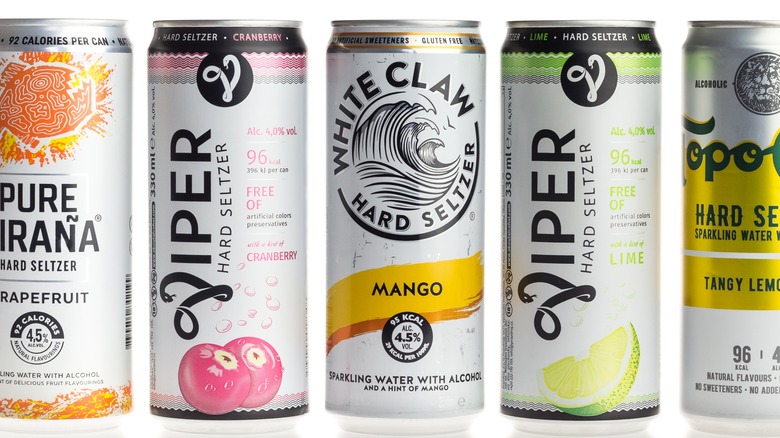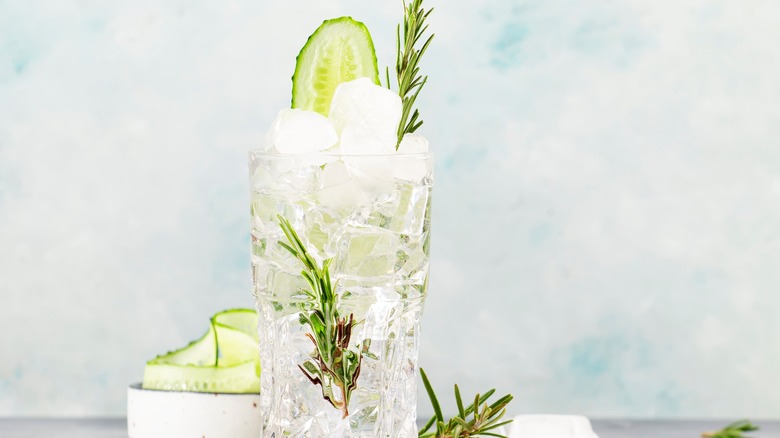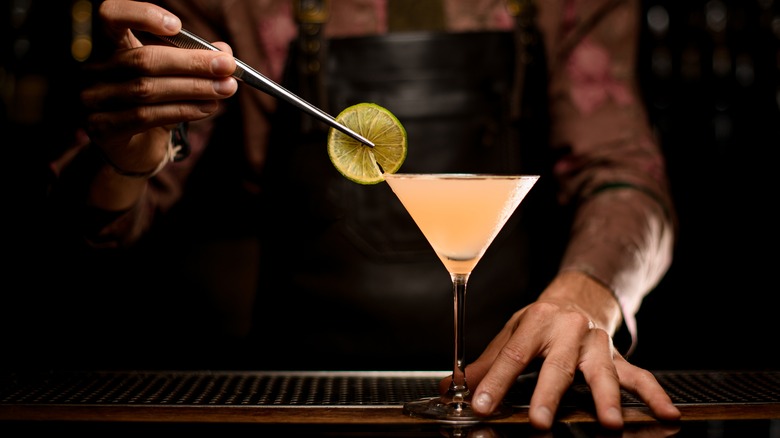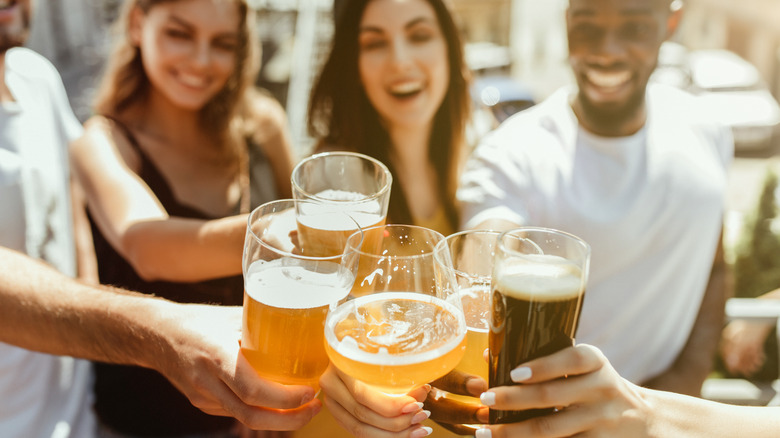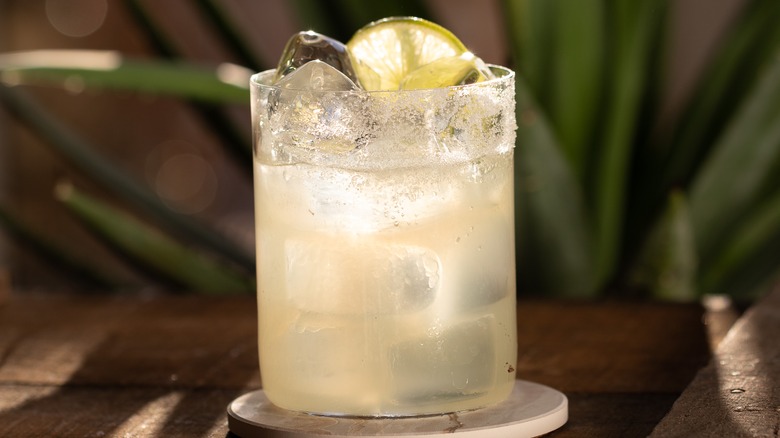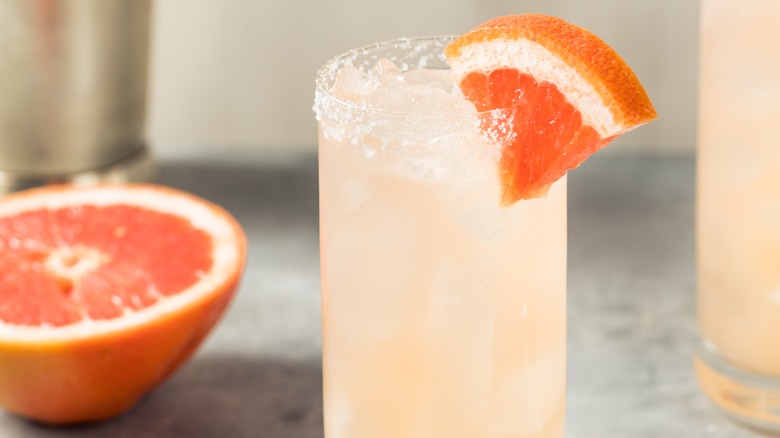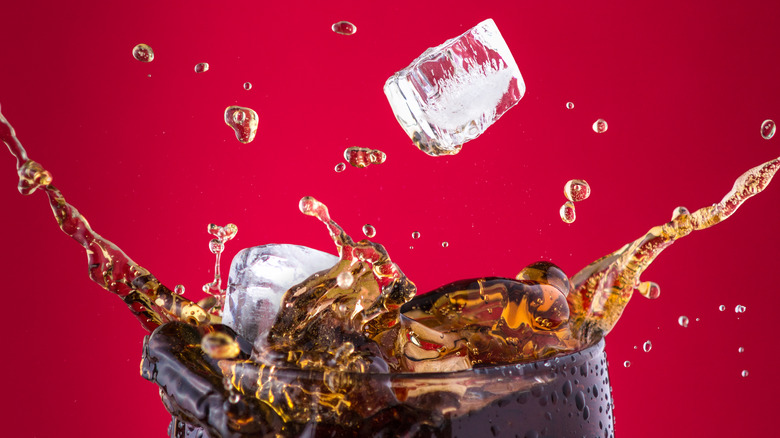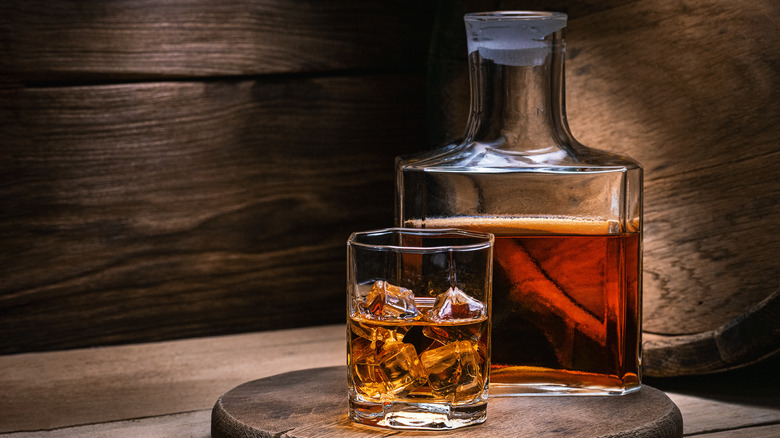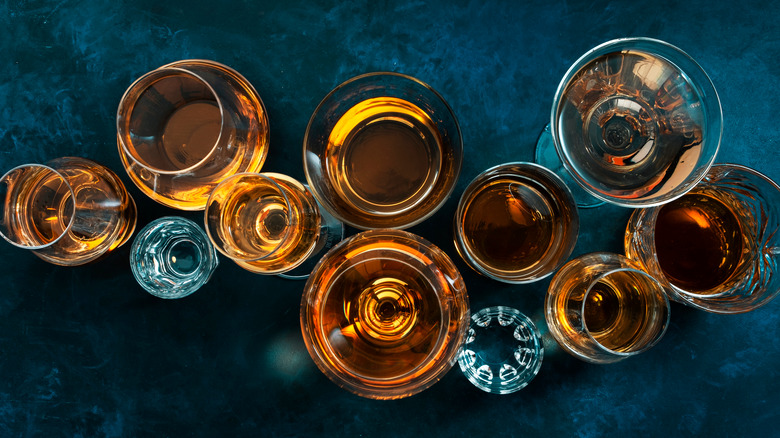Alcoholic Drinks With Fewer Calories To Order Next Time You're Out
Who doesn't like cracking open a cold one after a long day? There's no shame in enjoying the occasional alcoholic drink. But when it comes to weight loss, you should consider not only what you are eating, but what you're drinking, too.
Whether you're trying to lose weight or want to avoid growing the classic beer belly, it's important to remember that alcohol contains calories — and depending on your beverage of choice, sometimes, it's a lot. Alcohol is often considered empty calories because it has little nutritional value but a high calorie count. One pint of beer at 5% alcohol contains an average of 239 calories, which is the same as eating a Mars candy bar (via the National Health Service). Most alcohol is made by fermenting natural starch and sugar, which contributes to its calorie load. On top of that, many cocktails have added sugar in them, which causes the calorie count to skyrocket.
But don't worry: You don't have to swear off booze altogether. The key is being mindful about what you order. Let's explore some alcoholic drinks you can enjoy without consuming the equivalent caloric count of a giant piece of chocolate cake.
Vodka soda
Vodka soda is one of the most classic bar beverages — and there's a reason it's commonly referred to as the "skinny b*tch" drink. In fact, it's the drink of choice for the women in the reality television show "The Real Housewives of Sydney" due to its low calorie content (via leaf). When it comes to booze, hard liquors tend to be quite low in calories, because they are basically ethanol without any added sugar. And vodka has a super low calorie count, with about 100 calories in a single 50-milliliter shot (via Esquire).
A vodka soda is typically made by combining vodka with club soda — a standard serving of 7.5 ounces comes in at 133 calories, making it one of the lowest-calorie alcoholic drinks out there (via Healthline). To spice up the flavor, you can add fresh lemon juice, lime juice, cucumber, or mint. And if you're not a fan of club soda, try using flavored sparkling water instead. Just be sure not to add a sugary drink like Coca-Cola or Red Bull to the mix, since those mixers are loaded with calories.
White wine
We've all been led to believe that drinking wine is good for us, but what about its calorie count?
If you are having a hard time choosing between red or white wine, the latter generally has fewer calories than the former, but not by much (via Healthline). A glass of white wine with a standard 5-ounce pour has about 121 calories, while the same amount of red wine contains about 125 calories. In addition, try to choose dry wines over sweet ones, because those tend to have more calories. On average, a dry wine has less than one gram of sugar per ounce, while sweeter wines can contain more than double that, at 2 grams of sugar per ounce. And more sugar, of course, means more calories.
The next time you pop a bottle, go for a dry white wine like Pinot Blanc, Sauvignon Blanc or Pinot Grigio (via Esquire).
Red wine
Even though red wine has a higher calorie content compared to white, it's still pretty low. Plus, red wine has a slightly higher nutritional value than white, with higher amounts of vitamins and minerals like riboflavin and manganese (via Healthline).
Red wine also comes with other potential health benefits, like supporting cardiovascular health, boosting healthy cholesterol levels, and improving brain function. These advantages are linked to the compound resveratrol, which is found in red wine and has antioxidant and anti-inflammatory properties. Resveratrol has also been connected with decreasing joint pain, reducing symptoms of diabetes, fighting cancer, and even helping you live longer.
Just make sure to choose dry red wines over sweet ones, like Pinot Noir, Merlot, and Cabernet Sauvignon (via Esquire). And the more you drink, the more calories you consume — stick to the Centers for Disease Control and Prevention's recommendation of 1 drink per day for women and 2 drinks per day for men.
Wine spritzer
A tasty, low-calorie way to get that wine calorie count down is to add sparkling water. Just don't add too much — after all, you don't want it to taste watered down.
A wine spritzer is typically made by adding club soda or sparkling water to chilled white wine, with ice and other added garnishes like fresh herbs or citrus peels. The traditional "lighter" ratio is equal parts wine and seltzer water (via Masterclass). It's a classic summer go-to beverage, but you can drink one any time of year to embrace those summertime vibes.
To add some more flavor, you can throw in some citrus juice or fresh fruit like raspberries, blackberries, pomegranate, or mango. However, if you really want to add fruit juice, opt for a splash, since most are packed with sugar. Depending on how you make it, a wine spritzer can average about 100 to 125 calories per glass (via Taste of Home).
Hard seltzer
Hard seltzer is another low-calorie alcoholic beverage in the seltzer realm. Spiked seltzers seemingly gained popularity overnight — these days, almost every company out there is making their own version of one. Most store shelves are stock-piled with different brands, there's almost as many hard seltzer flavor options as there are chip flavors to choose from.
Hard seltzers are marketed as low calorie, which is true: A 12-ounce can of mango hard seltzer contains only 99 calories, depending on what brand you reach for (via Healthline). That means a hard seltzer has fewer calories than a pint of beer and a glass of wine, and it's definitely a lower-calorie option compared to a sugary cocktail or hard cider. Hard seltzers are made by mixing seltzer water with alcohol from fermented cane sugar and other natural flavors, sometimes even real fruit juice. It's basically like a vodka soda in a can.
Gin and diet tonic
The gin and tonic is considered a classy and classic cocktail — but what many people don't know is that it comes packed with calories.
Tonic water contains quinine, an extract from the bark of a tree in Peru, which is naturally quite bitter. Typically, high fructose corn syrup is added into the tonic water to cut that bitterness and make the drink taste better (via Healthy Living). But high-fructose corn syrup is all sugar and bursting with calories. A 12-ounce glass of tonic water contains 124 calories — and that's without the gin.
So next time you get a gin and tonic craving, swap the tonic water for diet tonic, which has 0 calories per serving (via Healthline). A gin and diet tonic with a 2-ounce shot of gin is about 128 calories. And if you want the calorie content even lower, you can order it with less gin and more ice and diet tonic water.
Dry martini
A martini is another classic cocktail commonly ordered at bars. Typically, this drink is made with a mixture of gin and vermouth and garnished with olives or citrus slices.
A traditional martini is made with 3 parts gin to 1 part vermouth (via Masterclass). However, if you order a dry martini, it's made with the same amount of gin, but just a dash of vermouth. And an "extra-dry" just contains a couple drops of vermouth, to get the essence of its flavor (via Insider).
In general, less alcohol means fewer calories, so a dry martini is the way to go. Some would argue, though, that vermouth makes this drink, and is what gives it that martini flavor — so if you order an extra-dry martini, well, that's just gin. If you drink a dry martini with about 2.5 ounces of gin and 0.5 ounces of vermouth, you will be consuming around 185 calories (via Healthline).
Light beer
If you crave that beer flavor but don't want all the calories, nutritionist Amy Gorin recommends choosing light beer over traditional beer (via Women's Health Magazine). While the official calorie count of a beer depends on the type and brewer, generally speaking, a 12-ounce serving of traditional beer has about 150 calories, while light beer contains anywhere from 50 to 100 calories. Also, keep in mind that a classic pint equals 16 ounces.
"Calories in beer come from two components — alcohol and carbohydrates (starches and sugar from unfermented grain)," says dietitian Tricia Leininger (via Unity Point Health). "The calories in beer are mostly influenced by the alcohol content. Light beer has fewer calories via less alcohol content."
So how do you know if a beer is "light"? It's usually in the name. Some of the best light beers to choose from include Kona Light Blonde Ale, Miller Lite, and Omission Brewing Co's Ultimate Light Golden Ale.
Margarita with a twist
There's nothing quite like a refreshing margarita, but most of them have so much sugar that they can reach calorie counts of 300 or more (via Taste of Home).
If you opt to make one at home, don't think that you're cutting calories if you use a pre-made margarita mixer — 4 ounces of the Original Classic Lime Margarita Mix made by Jose Cuervo contains 110 calories and a whopping 24 grams of sugar (via fitbit). Instead, make your own low-calorie margarita by mixing sparkling water with fresh citrus juice, tequila, triple sec and just a dash of sugar; this comes out to about 150 calories. Avoid using simple syrup, as they tend to increase the sugar and calorie count.
But what if you're out at a bar and you suddenly crave a margarita? You can try ordering a tequila soda with lime and a splash of triple sec.
Paloma
You can think of a paloma as kind of a low-calorie margarita without the added sugar. That's because this drink involves tequila and some of the flavors that are in a traditional margarita (like lime), but skips the addition of the sugary margarita mix.
A popular Mexican cocktail, the name paloma comes from the Spanish word for grapefruit, "pomelo" (via Texas Monthly). Typically, a paloma is made by mixing tequila, grapefruit juice, and lime juice. Sometimes club soda or even fruit-flavored soda are included, and sugar is often added as well. For this reason, make sure when you order a paloma at a bar to specify no added sugar. Also, it's a good idea to request fresh squeezed fruit over fruit juice to help keep calories down (via Women's Health Magazine). You can also add a garnish of a lime or grapefruit wedge, and even line the rim with salt for that classic Mexican cocktail taste and look.
Champagne
Champagne may not be an obvious low-calorie choice when it comes to alcohol. However, a 6-ounce glass of regular champagne comes out to only about 120 calories (via Taste of Home). Of course, if you make it a mimosa, that changes things. If you're seeking a flavorful addition, try adding a couple piece of fruit instead, like raspberries.
Now, let's get into the specifics: Champagne is made by grapes fermenting over many years, and towards the end of the process, the bottle is opened to remove the yeast and add in a bit of sugar. That's why champagne is traditionally sweet, but if you go for "brut" champagne, you'll get a drier drink — the standard brut only has about 15 grams of sugar per bottle (via The Guardian). You might also be able to find "ultra-brut" champagne, which has anywhere from 0 to 6 grams of sugar added. A glass of brut champagne has 90 to 100 calories, while an ultra-brut contains only 59 to 65 calories.
Rum and not Coke
Another classic cocktail, rum and Coke packs quite the caloric punch, mainly due to the Coke. According to the company's official website, a 12-ounce can of Coca-Cola has 140 calories and 39 grams of sugar — that's nearly 10 teaspoons of sugar, following the conversion guidelines from Michigan State University. Try swapping the Coke with Diet Coke for a lower-calorie option with less sugar.
An 8-ounce glass of rum and Coke is a hefty 185 calories (via MedlinePlus). Meanwhile, the same size glass of rum and Diet Coke only comes in at 100 calories — that's the same amount of calories as a can of hard seltzer. Alternatively, if you want to go all-natural, you can try nixing the soda altogether and drink your rum with unsweetened black tea; think of it as a healthier rum and Red Bull. One cup of unsweetened black tea contains only 2 calories (via Women's Health Magazine).
Whiskey
Vodka and rum tie for the lowest calorie content in hard alcohols: each shot contains about 97 calories (via Women's Health Magazine). But whiskey comes in third, at about 105 calories in a single shot.
While it's not common to witness someone drinking vodka straight, many people enjoy sipping on just whiskey. The next time you're out, try ordering whiskey straight or on the rocks — that's whiskey over ice — for a super low-calorie beverage. Or try mixing it with club soda or sparkling water for a little oomph.
If just the thought of that makes you cringe, you can try sipping on a Manhattan instead (via Esquire). This classic drink is a mixture of whiskey, sweet vermouth, and bitters, which means it's low in calories, carbs, and sugars. Or you can try an old fashioned, which lives up to its name — just whiskey, Angosturan bitters, and an orange slice.
Tips to cut calories
Ultimately, alcohol isn't necessarily considered high-calorie on its own. However, it's the high-sugar drinks that are typically added into cocktails that are the culprit (via Women's Health Magazine). When ordering out, opt for drinks with low-sugar content — and when in doubt, ask the bartender if they can make it sugar-free.
Also, some people might wrongly assume that drinking a single drink with a high alcohol content will help cut calories compared to drinking two drinks with a lower alcohol content. The reality is that the higher the alcohol percentage, the higher the calorie content. For example, if you're choosing vodka because it's one of the lowest-calorie hard liquors out there, keep in mind what percentage alcohol you're choosing. A bottle of 80-proof vodka — that's 40% alcohol — has 64 calories in 1 ounce, while a bottle that's 100-proof (or 50% alcohol) contains 82 calories per ounce (via Esquire).

